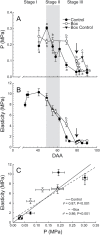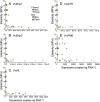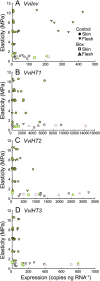Characterization of major ripening events during softening in grape: turgor, sugar accumulation, abscisic acid metabolism, colour development, and their relationship with growth
- PMID: 26590311
- PMCID: PMC4737070
- DOI: 10.1093/jxb/erv483
Characterization of major ripening events during softening in grape: turgor, sugar accumulation, abscisic acid metabolism, colour development, and their relationship with growth
Abstract
Along with sugar accumulation and colour development, softening is an important physiological change during the onset of ripening in fruits. In this work, we investigated the relationships among major events during softening in grape (Vitis vinifera L.) by quantifying elasticity in individual berries. In addition, we delayed softening and inhibited sugar accumulation using a mechanical growth-preventing treatment in order to identify processes that are sugar and/or growth dependent. Ripening processes commenced on various days after anthesis, but always at similarly low elasticity and turgor. Much of the softening occurred in the absence of other changes in berry physiology investigated here. Several genes encoding key cell wall-modifying enzymes were not up-regulated until softening was largely completed, suggesting softening may result primarily from decreases in turgor. Similarly, there was no decrease in solute potential, increase in sugar concentration, or colour development until elasticity and turgor were near minimum values, and these processes were inhibited when berry growth was prevented. Increases in abscisic acid occurred early during softening and in the absence of significant expression of the V. vinifera 9-cis-epoxycarotenoid dioxygenases. However, these increases were coincident with decreases in the abscisic acid catabolite diphasic acid, indicating that initial increases in abscisic acid may result from decreases in catabolism and/or exogenous import. These data suggest that softening, decreases in turgor, and increases in abscisic acid represent some of the earliest events during the onset of ripening. Later, physical growth, further increases in abscisic acid, and the accumulation of sugar are integral for colour development.
Keywords: Anthocyanins; Vitis vinifera L.; cell wall; elasticity; firmness; fruit development.
© The Author 2015. Published by Oxford University Press on behalf of the Society for Experimental Biology.
Figures








References
-
- Agasse A, Vignault C, Kappel C, Conde C, Delrot S. 2009. Grapevine Molecular Physiology & Biotechnology (Roubelakis-Angelakis KA, Ed.). Dordrecht: Springer Netherlands.
-
- Barnavon L, Doco T, Terrier N, Ageorges A, Romieu C, Pellerin P. 2000. Analysis of cell wall neutral sugar composition, -galactosidase activity and a related cDNA clone throughout the development of Vitis vinifera grape berries. Plant Physiology and Biochemistry 38, 289–300.
-
- Brummell DA. 2006. Cell wall disassembly in ripening fruit. Functional Plant Biology 33, 103–119. - PubMed
-
- Brummell DA, Harpster MH. 2001. Cell wall metabolism in fruit softening and quality and its manipulation in transgenic plants. Plant Molecular Biology 47, 311–340. - PubMed
Publication types
MeSH terms
Substances
LinkOut - more resources
Full Text Sources
Other Literature Sources

